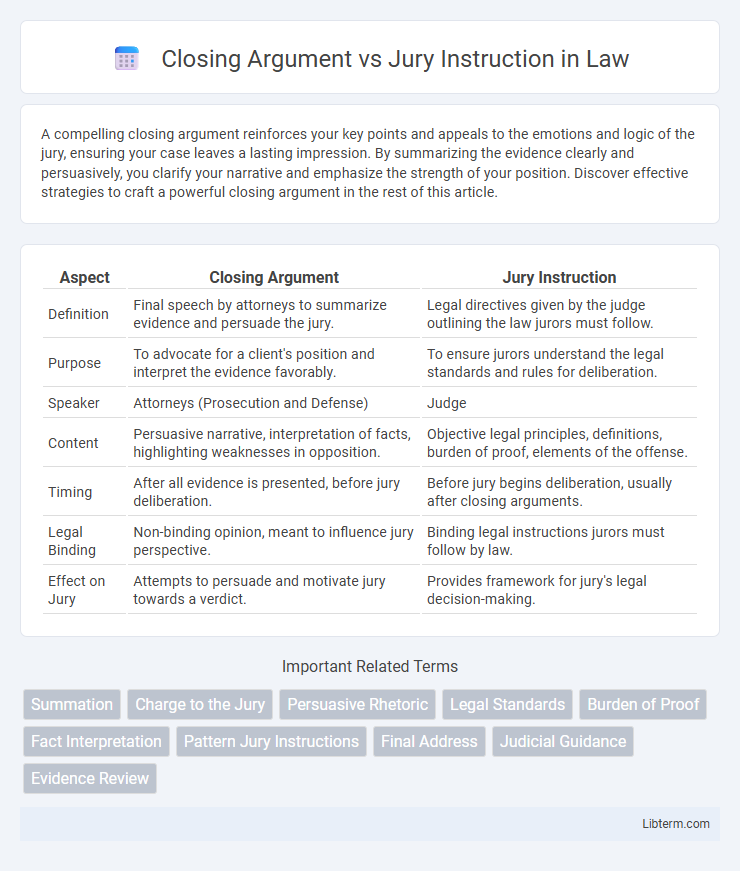A compelling closing argument reinforces your key points and appeals to the emotions and logic of the jury, ensuring your case leaves a lasting impression. By summarizing the evidence clearly and persuasively, you clarify your narrative and emphasize the strength of your position. Discover effective strategies to craft a powerful closing argument in the rest of this article.
Table of Comparison
| Aspect | Closing Argument | Jury Instruction |
|---|---|---|
| Definition | Final speech by attorneys to summarize evidence and persuade the jury. | Legal directives given by the judge outlining the law jurors must follow. |
| Purpose | To advocate for a client's position and interpret the evidence favorably. | To ensure jurors understand the legal standards and rules for deliberation. |
| Speaker | Attorneys (Prosecution and Defense) | Judge |
| Content | Persuasive narrative, interpretation of facts, highlighting weaknesses in opposition. | Objective legal principles, definitions, burden of proof, elements of the offense. |
| Timing | After all evidence is presented, before jury deliberation. | Before jury begins deliberation, usually after closing arguments. |
| Legal Binding | Non-binding opinion, meant to influence jury perspective. | Binding legal instructions jurors must follow by law. |
| Effect on Jury | Attempts to persuade and motivate jury towards a verdict. | Provides framework for jury's legal decision-making. |
Introduction to Closing Arguments and Jury Instructions
Closing arguments provide attorneys the opportunity to summarize evidence and highlight key points to persuade the jury toward a favorable verdict. Jury instructions are the judge's guidance on legal standards and how to apply the law to the facts presented during the trial. Both closing arguments and jury instructions play crucial roles in shaping the jury's understanding and decision-making process.
Definition of Closing Arguments
Closing arguments are the final statements presented by attorneys to the jury summarizing the evidence and highlighting key points to persuade the jury toward a specific verdict. These arguments synthesize facts, legal standards, and witness testimonies to reinforce the desired interpretation of the case. Unlike jury instructions, which are legal guidelines provided by the judge explaining the laws applicable to the case, closing arguments aim to influence the jury's decision-making through persuasive narrative.
Definition of Jury Instructions
Jury instructions are legal guidelines provided by the judge to the jury, explaining the laws applicable to the case and outlining the standards for evaluating the evidence presented during the trial. These instructions ensure jurors understand their duties, the elements of each claim, and the burden of proof required to reach a verdict. Unlike closing arguments, which are persuasive summaries by attorneys, jury instructions serve as impartial legal frameworks that govern the jury's deliberation process.
Purpose of Closing Arguments in a Trial
Closing arguments serve to summarize the evidence presented during a trial and persuade the jury toward a favorable verdict based on that evidence. They provide attorneys the opportunity to interpret facts, highlight key testimonies, and reinforce their legal theories before the jury deliberates. Unlike jury instructions, closing arguments are persuasive, aiming to influence the jury's understanding and application of the law as explained by the judge.
Purpose of Jury Instructions for the Verdict
Jury instructions serve the critical purpose of guiding jurors on the legal standards they must apply to the evidence when reaching a verdict. These instructions clarify the elements of the charges, define key legal terms, and outline the burden of proof necessary for conviction or acquittal. Unlike closing arguments, which advocate one party's interpretation of the case, jury instructions provide an impartial legal framework to ensure a fair and consistent decision.
Key Differences Between Closing Arguments and Jury Instructions
Closing arguments are persuasive speeches delivered by attorneys summarizing evidence to influence the jury's decision, while jury instructions consist of the judge's formal legal guidelines explaining the law and standards the jury must apply. Closing arguments allow attorneys to interpret facts and highlight favorable evidence, whereas jury instructions provide neutral, authoritative rules governing the deliberation process. The key difference lies in the advocacy role of closing arguments compared to the objective, binding legal framework established by jury instructions.
Legal Standards Governing Closing Arguments
Closing arguments must adhere to strict legal standards prohibiting personal opinions, inflammatory statements, or misrepresentation of evidence to ensure fairness. Courts require attorneys to base their arguments on the evidence presented and refrain from appealing to jurors' emotions or biases. Violations of these standards can result in mistrials or appellate reversals, emphasizing the judiciary's role in maintaining procedural integrity.
Judicial Authority in Delivering Jury Instructions
Judicial authority in delivering jury instructions is a critical function that ensures jurors understand legal standards and the framework for their verdict. Unlike closing arguments, which are persuasive summaries presented by attorneys, jury instructions come directly from the judge and carry official weight as the final interpretation of the law. Accurate and clear instructions safeguard the fairness of the trial by guiding jurors on how to apply legal principles to the facts without bias or error.
Impact on Jury Decision-Making
Closing arguments synthesize evidence and persuade jurors by highlighting key facts, framing narratives to influence emotional and logical reasoning. Jury instructions provide legal standards and criteria, shaping jurors' understanding of the law and guiding their deliberation parameters. Both elements crucially impact jury decision-making by blending persuasive storytelling with authoritative legal frameworks.
Conclusion: Distinguishing Roles in the Trial Process
Closing arguments serve as persuasive summaries where attorneys highlight evidence and advocate for their client's position, aiming to influence the jury's perception. Jury instructions are judicial directives outlining legal standards and criteria jurors must apply when deliberating on the case. Understanding the distinct roles of closing arguments as advocacy and jury instructions as legal guidance clarifies their complementary functions in the trial process.
Closing Argument Infographic

 libterm.com
libterm.com